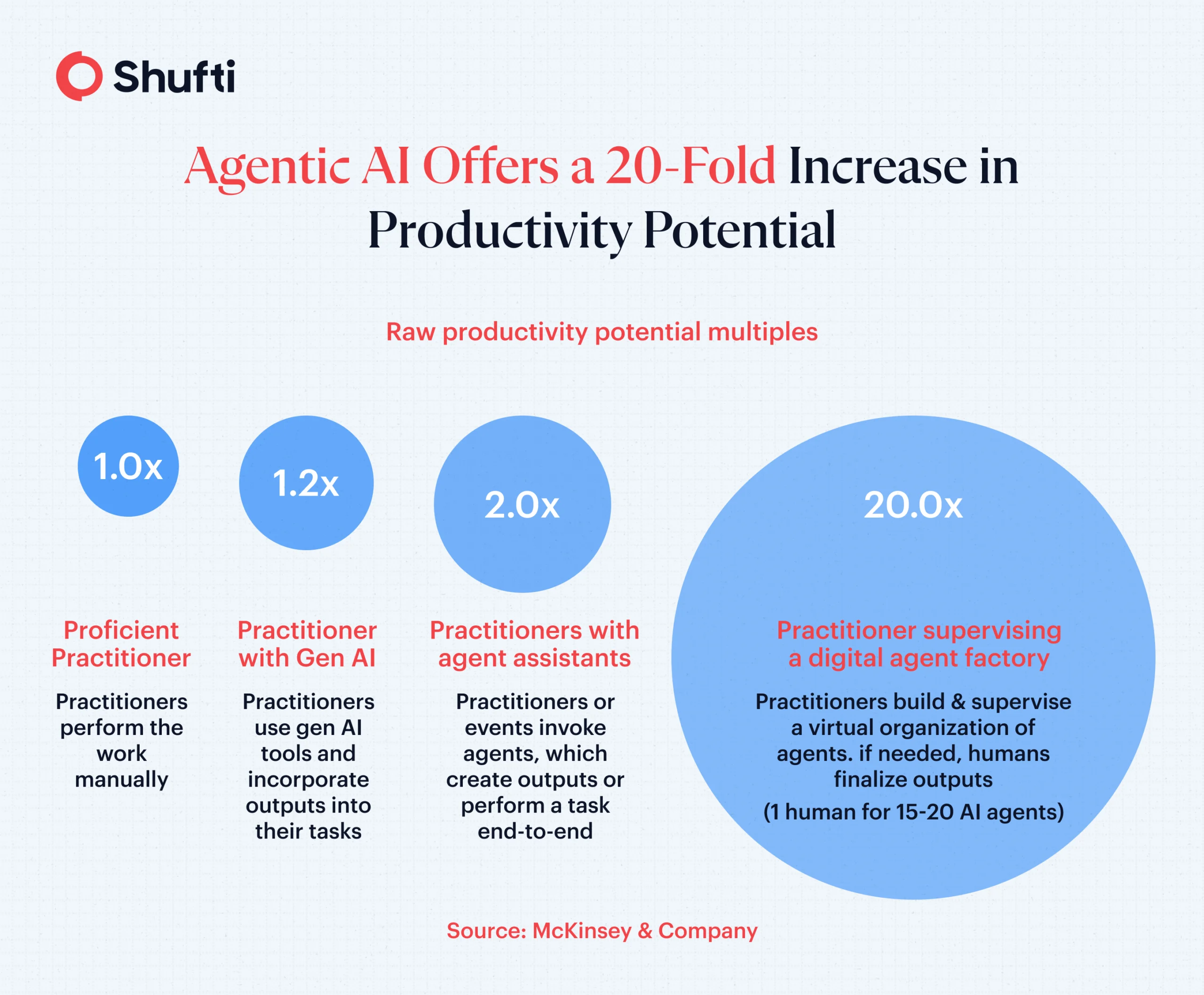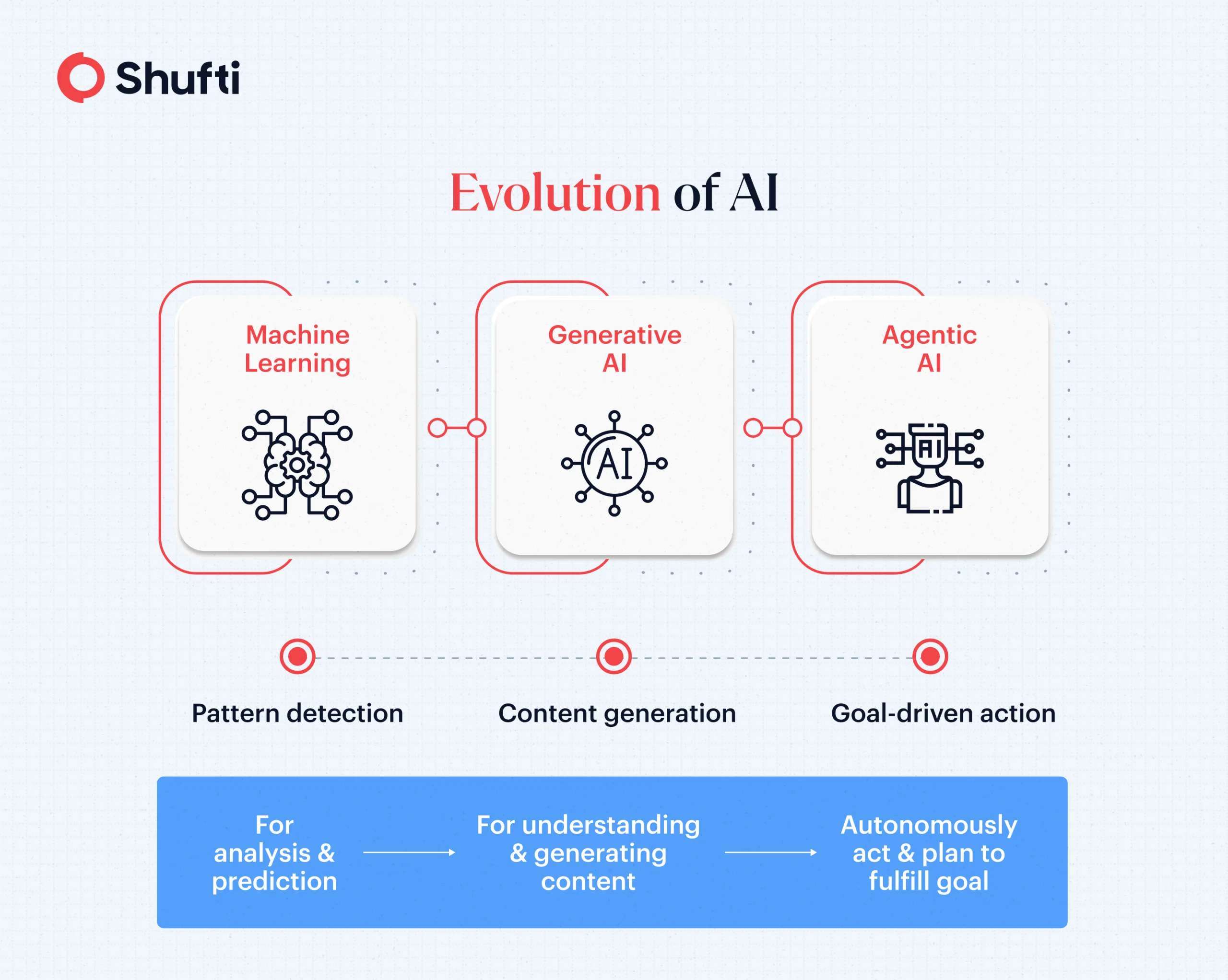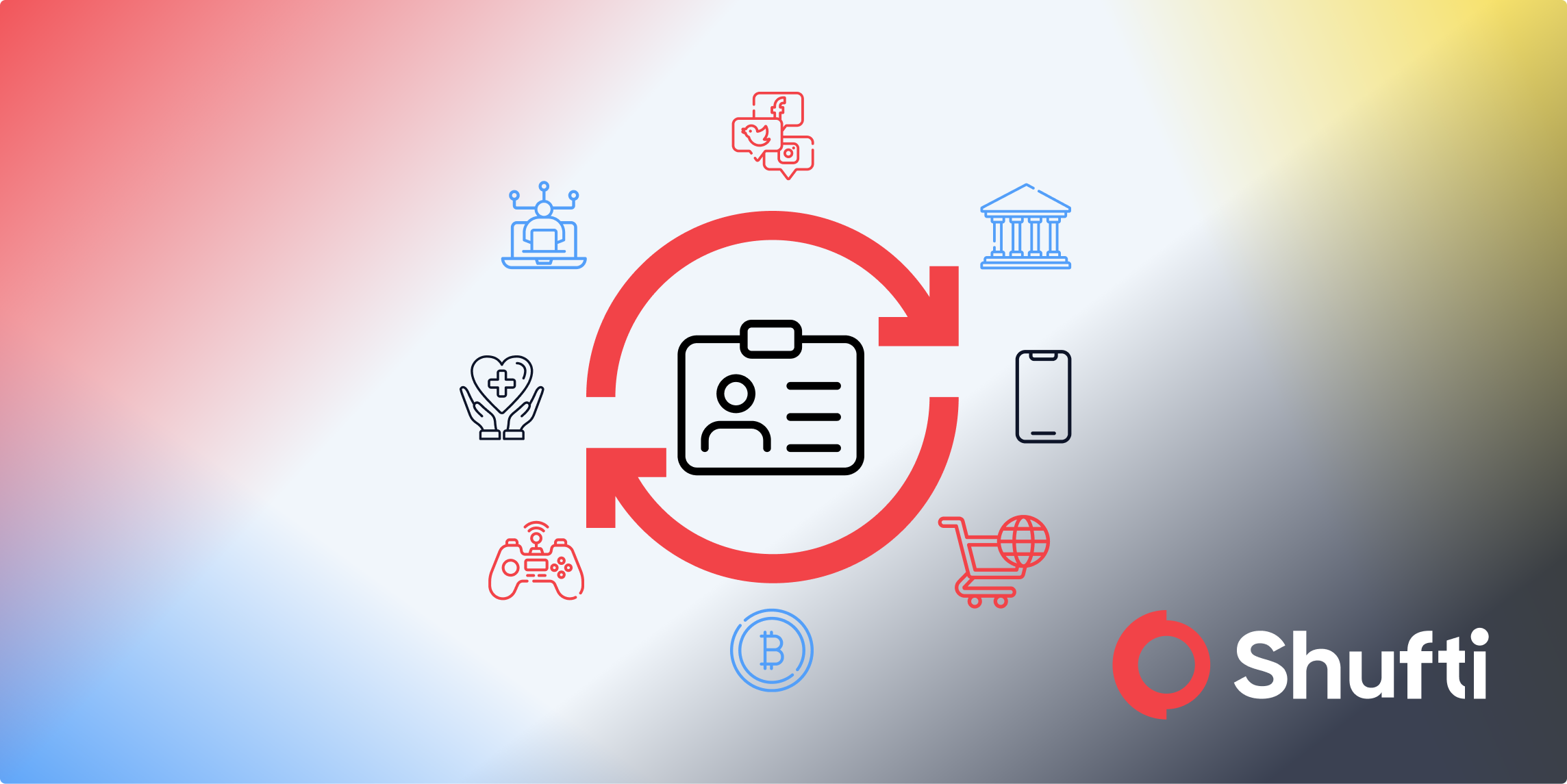What You Need to Know About Agentic AI in AML Compliance

- 01 What are the challenges compliance teams face with traditional financial crime investigations?
- 02 What is Agentic AI?
- 03 What is the difference between Generative AI (Gen AI) and Agentic AI in AML Compliance?
- 04 How Agentic AI works in KYC and AML Compliance?
- 05 Here’s how Shufti can help you operationalize Agentic AI
For financial institutions, the traditional method to investigate financial crime is to employ human resource teams that manually review each alert, gather evidence, and conduct research to resolve the alert.
However, this traditional method of financial crime investigation simply cannot keep up with the rapidly evolving economic landscape. As financial activity has grown, the volume of compliance alerts has also increased. The surge in financial activity is driving more alerts, which has made compliance more resource-intensive and costlier for financial institutions.
With more than 90% of transaction-monitoring alerts resulting in false positives, compliance officers spend more time resolving false positives than real alerts – utilizing crucial time and resources to no avail. Poor KYC and AML compliance solution systems categorize alerts requiring manual review, which in turn occupies human resources for something that turns out to be nothing more than a false positive.
Did you know?
According to the Bank Policy Institute (BPI), “the number of employee hours dedicated to complying with financial regulations across U.S banks and financial institutions increase by 61% between 2016 and 2023.”
The solution to make compliance workflows efficient is not to hire more compliance teams; it is to automate the compliance process with AI. With such large amounts of data to sift through, human workforces are simply unfit to resolve every alert in a timely manner before moving on to the next. Automation, in the form of AI Agents, resolves that problem by efficiently processing large amounts of compliance data faster than any human-led compliance teams.
What are the challenges compliance teams face with traditional financial crime investigations?
The current approach of financial institutions towards financial risk investigations has not been effective in intercepting financial crime. Despite banks commonly assigning 10-15 percent of their workforce to KYC/AML compliance, the financial industry has only managed to detect 2 percent of prohibited financial transactions between 2015 and 2022, according to Interpol.
But what is the reason behind such ineffective AML compliance?
-
High-Alert Volume:
Anti-Money Laundering (AML) monitoring and transaction systems generate a high amount of alerts. With 90% of these alerts resulting in false positives, compliance teams are overwhelmed with the obligation to manually review an alert that is likely to be false.
-
Inconsistent Documentation:
When the alerts are manually reviewed, compliance officers must provide a rationale for the decision they undertook after review. Writing clear, defensible rationales varies from one compliance officer to another; inconsistent documentation requires even more man-hours to resolve.
-
Time Constraints:
Due to the high volume of alerts generated, compliance officers face a time crunch to review and decide on alerts quickly, significantly increasing the risk of overlooking important details.
These challenges illustrate the need for a new method of financial crime investigation that is more efficient and accurate than the traditional method of human-led compliance teams manually reviewing alerts.
What is Agentic AI?
Agentic AI is an evolutionary AI system that can act autonomously to achieve goals and even perform tasks on behalf of compliance officers. As the name suggests, it is an autonomous AI agent that will fulfill the goals it is dedicated to.
For financial crime investigation, Agentic AI can enable single or multiple AI agents to act autonomously for activities such as client onboarding, identity verification, transaction monitoring, sanctions, or fraud investigations from the moment the alert is generated to when it is closed.
In simple terms, think of Agentic AI as a virtual compliance officer that requires minimal human intervention and can carry out context-aware investigations in seconds. This evolution in AI allows financial institutions to rely on multiple AI agents to carry out end-to-end tasks, which only requires oversight from the human-led teams. This allows compliance teams to resolve the high volume of alerts in a timely, accurate, and cost-effective manner.
Did You Know?
According to research by McKenzie & Company, given that each human compliance officer can supervise 20 or more AI agents on average, the production gain can be anywhere from 200 to 2000 percent, with a substantial positive impact on the quality and consistency of output.
However, it is important to know that Agentic AI is not a replacement for human-led compliance teams. While Agentic AI can handle the high amount of alerts, standardize documentation, and cut the time to decision, it cannot yet replace human accountability or oversight.

What is the difference between Generative AI (Gen AI) and Agentic AI in AML Compliance?
Gen AI is an AI system that is useful for creating various forms of content (text, image, videos, etc). This AI model learns patterns from large data sets and utilizes those patterns to generate content for the user. The use cases of Gen AI in KYC are multiple:
- Support – Gen AI can support human compliance officers by analyzing user data to ensure secure and convenient customer onboarding.
- Time Saving – This technology can help summarize large sets of KYC/AML data, such as adverse media reports, source of funds, in seconds for compliance teams to review.
- Effective Transaction Monitoring – Gen AI can assist in writing the rationale for alert decisions and support compliance teams in drafting SARs.
Agentic AI, on the other hand, goes a step further than Gen AI. Agentic AI in KYC and Agentic AI in AML do not just generate content when prompted by the compliance officer; they carry out end-to-end functions to achieve their predefined goal.
An AI Agent serves as a supervised digital teammate for Agentic AI in both KYC and AML. It determines the next best step, initiates IDV checks, triggers sanctions screening, requests additional evidence, drafts a rationale, and escalates only when necessary, while logging every action for audit purposes.
This creates measurable gains in speed, precision, and consistency across onboarding screening and investigations. The integration of Agentic AI demonstrates how financial institutions can turn their Know Your Customer AI solution or AML AI solution into a model that delivers effective outcomes, rather than isolated assists for analysts.

How Agentic AI works in KYC and AML Compliance?
-
Identity Verification (AI in IDV):
An agent can orchestrate document capture, liveness, and data validation in a single flow. If a selfie-to-ID match is borderline, the agent can request a second factor, ask for a more precise capture, or route to a senior reviewer. The AI agent records the decision tree and artifacts for later audit.
-
Sanctions and PEP name screening:
For AML risk assessment, agentic AI can streamline case management in multiple ways. Instead of passing raw matches to humans, the agent cross-checks date of birth, geography, and occupation; consults internal KYC profiles; assigns a confidence score; and drafts a “why not a match” note when evidence supports clearing. This directly tackles alert fatigue in AI AML compliance programs.
-
Adverse Media:
Agents can search approved sources, cluster duplicate stories, extract offense, date, and jurisdiction, and propose a concise summary aligned with policy language. Additionally, AI agents can also help compliance officers with diverse customer risk assessments through searching approved media sources.
-
Transaction Monitoring Investigation:
When an alert notification is received, the agent pulls KYC risk ratings, previous SAR context, counterparties, and other relevant data. It runs policy checks and proposes either escalation or closure with a pre-filled rationale. Compliance agents can then review, amend, and submit the report to their financial regulator. This aligns with a risk-based approach under FATF expectations for ongoing monitoring.
-
Perpetual KYC:
Agents watch for triggers like expired documents, new PEP status, or sanctions changes and proactively initiate reviews, with a bounded set of actions and a clear human checkpoint.
Here’s how Shufti can help you operationalize Agentic AI
Shufti offers the building blocks a compliance-grade agent needs across AI in KYC, AI in IDV, and AI for AML in banking compliance:
- KYC and IDV signals enable your agents to make real-time calls, including document checks, liveness, and biometric verification.
- Simplifies AML case management for initial customer risk assessment, which significantly reduces false positive alerts and helps reduce the burden on compliance teams
- Developer-ready docs and APIs for embedding verification and watchlist screening into your agent’s toolset.
With Shufti’s solutions, you can ensure that your AI agents are secure and compliant while streamlining your AML case management. Shuft’s
- Advanced IDV solution authenticates AI agents by verifying their identity to ensure they are legitimate and authorized before interacting with your system or data, enhancing security and compliance.
- AML AI Agent solution powers case management by automating the screening process, significantly reducing false positives and improving the efficiency of your compliance operations.
Speak with one of our specialists today to discover how we can enhance your compliance process with innovative and secure solutions.
Frequently Asked Questions
What is Agentic AI, and how does it enhance AML compliance?
Agentic AI is an autonomous system that can handle end-to-end tasks, such as KYC/AML screening and case management, with minimal human intervention. It enhances AML compliance by automating processes, reducing false positives, and improving efficiency, all while ensuring auditability and consistency.
How does Agentic AI work?
Agentic AI works by autonomously handling specific tasks like identity verification, transaction monitoring, and sanctions screening. It analyzes data, makes decisions based on predefined policies, and escalates only when necessary, all while recording every action for compliance and audit purposes.
What are some key use cases and applications of Agentic AI across industries?
Agentic AI is used in financial services for automating KYC/AML compliance, in healthcare for patient data management, and in customer service to power automated support systems. Its ability to handle large volumes of data quickly and accurately makes it applicable across various sectors.
How is AI (especially Agentic AI) being integrated into AML systems?
Agentic AI is integrated into AML systems to automate the detection of suspicious transactions, review alerts, validate KYC data, and manage cases. It reduces manual work by acting autonomously for routine tasks and escalating only when necessary.
What is the difference between GenAI and Agentic AI?
GenAI generates content like text or images based on data patterns, while Agentic AI goes a step further, taking actions autonomously to achieve goals, such as automating case management, verifying identities, or processing transactions within regulatory frameworks.










